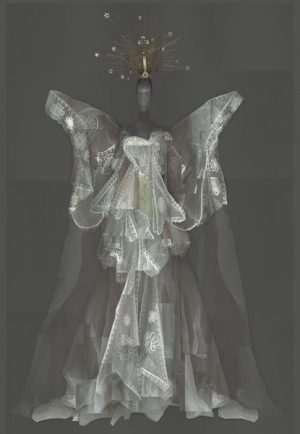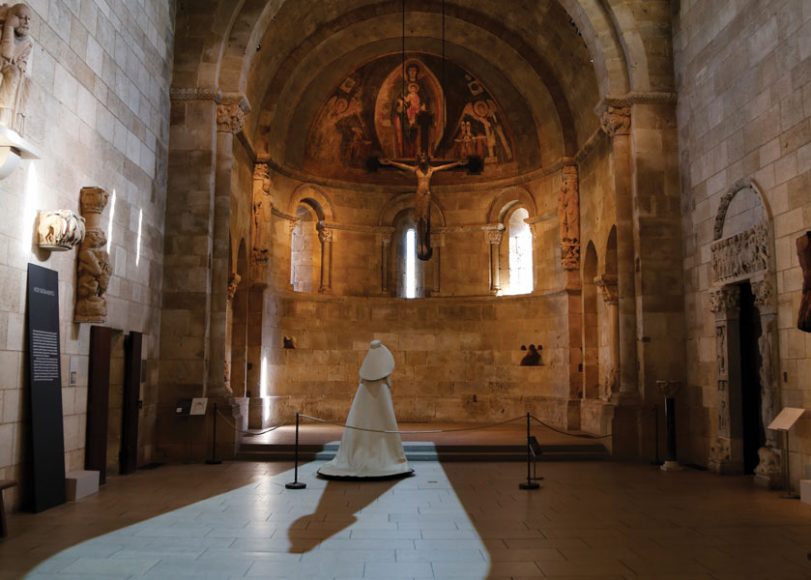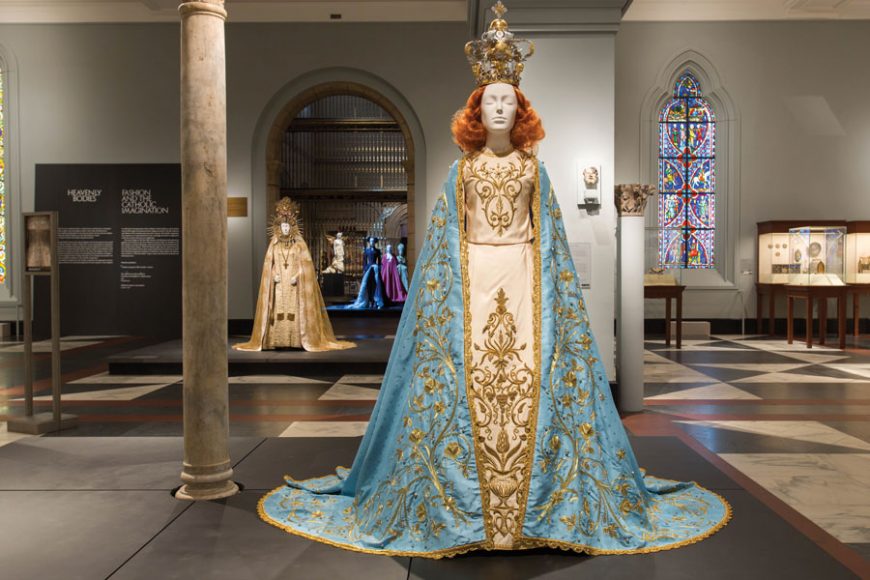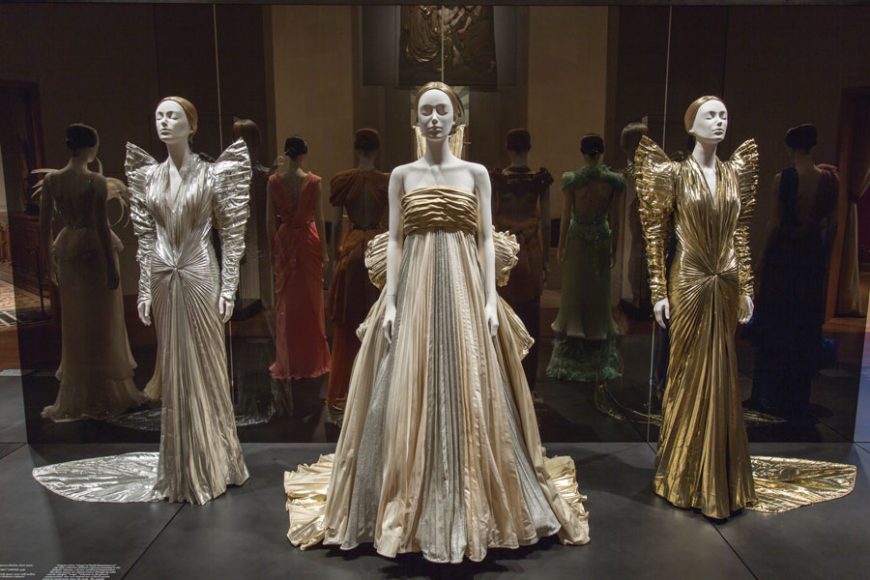“Heavenly Bodies: Fashion and the Catholic Imagination” — The Metropolitan Museum of Art’s much-ballyhooed Costume Institute exhibit running through Oct. 8 — is not what you would imagine, delightfully so.
Yes, there are some who have taken umbrage at such a visceral presentation of the fashion world’s long-standing appropriation of Roman Catholic imagery for everything from nightwear to wedding gowns. But then, these are generally the people who are outraged by everything, n’est-ce pas? Of course, the images of similarly attired celebrities at the recent Met Gala haven’t helped. (Why do women at these events always look as if they’re sporting draperies, channeling the Carol Burnett takeoff on Scarlett O’Hara in “Gone With the Wind”? All that was missing, in the gala’s instance, was the curtain rod.)
For the open-minded, however, there is a powerful idea at play in “Heavenly Bodies” that threads this show more surely than the gold in the papal vestments and Chanel cocktail dresses; and gleams more certainly than the rubies and emeralds in the papal tiaras and colored crystals in Dolce & Gabbana’s Byzantine-style dresses. That idea is how Christianity in general and the Catholic Church in particular conquered first an empire (Rome) and then a world by appealing in part to the tactile and the visual — much as fashion does.
Collaborating with colleagues in The Met’s Department of Medieval Art and at The Cloisters, Andrew Bolton — the Wendy Yu curator in charge of The Costume Institute — has fashioned a show that upends our expectations. You would think the more than 150 ensembles from A (Azzedine Alaïa) to V (Versace) would grace the Anna Wintour Costume Center galleries. Instead they are home to some 40 dazzling papal vestments and accessories from 15 papacies spanning the 18th through early 20th centuries — marking the most significant loan from The Vatican to The Met since “The Vatican Collections” show in 1983.
Meanwhile, the designer creations dot the medieval and Byzantine galleries and The Robert Lehman Wing in the main museum on Fifth Avenue as well as The Cloisters in Fort Tryon Park farther uptown — a clever marketing ploy that forces fashionistas who might not be as interested in the fine arts to commune with them as well. In these art-filled spaces, mannequins stand on pedestals for the fashion faithful to gaze up at. They cluster like choirs. They flit among topiaries. They worship at altars, like so many nuns or brides taking the veil — and thus taking on new identities. And, in the end, they lie in state alongside real effigies.

By placing the vestments in the costume center and the clothing in the art galleries among objects that once had real devotional purposes, Bolton and medieval curators C. Griffith Mann, Barbara Drake Boehm, Helen C. Evans and Melanie Holcomb have underscored the connection between the sacred and the profane, as it were, that exists in religion and all the arts.
In the costume center, you’ll find vestments like the dalmatic of Pius IX (reigned 1846-78), made of white silk gros de Tours embroidered with polychrome silk, gold and silver metal thread and gold paillettes. Students at Verona’s Istituto Femminile di Don Nicola Mazza meticulously embroidered intricate compositions such as the Flagellation and the Crowning with Thorns — scenes from Jesus’ Passion — depicted here. They specialized in figural work. Yet what is particularly striking is not just the craftsmanship but the sensuousness of the forms. This Jesus may suffer but he does so beautifully. And that speaks of a religion, of a Church that co-opted the Greco-Roman emphasis on the body, not just during its rediscovery during the Renaissance but from the very beginning. (Look, for instance, at the conflation of the tragic pastoral musician Orpheus with Jesus, the Good Shepherd, in the images in the Catacombs that helped succor the nascent Christian flock.)
There is a sensuousness to the papal vestments — and perhaps a sensuality as well. Certainly, that’s captured in the clothes throughout the exhibit — shimmering Versaces studded with crosses; a sheer gray silk net Valentino (2014) embroidered with Lucas Cranach the Elder’s “Adam and Eve” (1526) on the skirt; plunging, peekaboo Rodarte goddess gowns in Virgin Mary pinks, blues and golds.
If the spiritual finds a home in the sensual here, the sensual finally rests in the spiritual. At The Cloisters, where the strains of Franz Schubert’s “Ave Maria,” sung by Barbara Bonney, waft through the Romanesque and Gothic interiors — this is first Met show we’ve seen in which sounds are as important as sights — unadorned wedding dresses stand at attention in apses. There they perhaps await bridegrooms — instead of the other way around — but also remind us that nuns are the brides of Christ. One of these gowns — an ivory silk gazar and organza ensemble by Cristobal Balenciaga (1967) — faces the apse of the Fuentidueña Chapel, its rounded train mirroring the slice of light carved by the arc of one of the Romanesque windows. There is something so pure, so serene about the feelings the scene evokes. It’s like communing with the divine.
For some, such a thought borders on the sacrilegious. How can a dress — even one as seamless as the robe Jesus was stripped of — compete with the concept of God? It can’t, of course. But then again, the Church can’t have it both ways. Some 2,000 years ago, it created a brand that has stood the proverbial test of time.
It can hardly complain if others have chosen to run with it.
For more, visit metmuseum.org.





